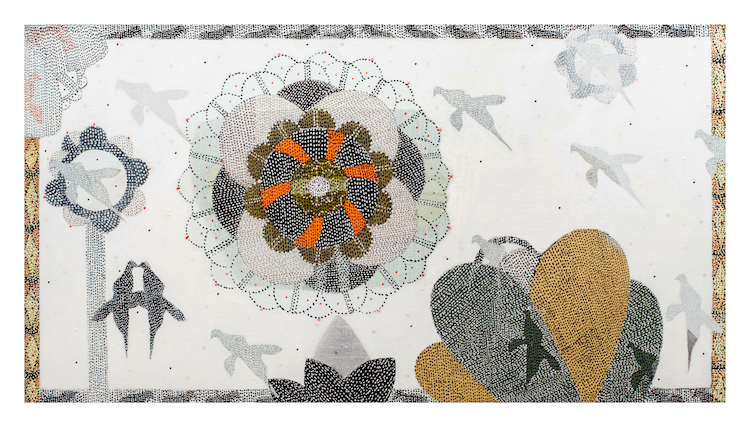Throughout his prolific, decades-long career, artist Glenn Goldberg has created work that explores structure and space. His use of tiny, methodically painted dots has become a signature for him, and the technique is present in many of the pieces on display at the George Washington University this week.
On Jan. 26, the
Luther W. Brady Art Gallery celebrates the opening of the exhibition, “Of Leaves and Clouds,” which showcases paintings, small ceramic objects and works on paper by Mr. Goldberg. Ahead of the opening, Mr. Goldberg spoke with George Washington Today and discussed his career, influences and his experience collaborating with Corcoran School of the Arts and Design students on a relief featured in “Of Leaves and Clouds.” The original exhibition was organized by FreedmanArt in New York, and this adaptation will travel to the Reading Public Museum in Reading, Pa., after its run at the Brady Art Gallery.
Q: Much of the work in this exhibition is notable for the precise, careful application of dots. In a previous interview, you mentioned you were interested in the Minimalism of the '70s early in your career. What factors led you to this signature style of dots and layered textures?
A: What happened, at a certain point, was that I needed to slow down and have works that happen over a longer period of time. Making small marks that accumulate into a form rather than making a form all at once provided for that. That choice separated out “art decisions” and “labor.” It allowed me to make a decision and then let labor take over. It also allowed my interest in cloth, weaving and textiles to be acknowledged. One can measure the work that went into a painting when it is built this way rather than experiencing a completed work that hides what went into it. Since my work is an additive process that does not remove anything as it proceeds, we can track the complete process that created the result.
Q: How has your process offered a lens for exploring nature—another theme present in this exhibition?
A: I actually don’t explore nature directly, but I work out of an interest in structure, related hierarchies and moods that exist in nature. My works are invented without viewing either nature or images of nature, but I feel that they are driven by what exists in nature. I can’t prove this, but that is the way that I feel. I am interested in art as a re-ordering of “what goes on.”
Q: This particular exhibition includes small ceramic objects as well as paintings and works on paper. How does your process and approach change depending on the medium?
A: When I work in a different material, I try to let the medium dictate my physical decisions. I am not trying to put a painting on the surface of a ceramic form. I want the color, surface and object to work together. I think of it more as a colored sculpture/object rather than a painting on a form or decorating an object. I want the color to feel embedded in the form rather than simply covering a surface.
Q: You gave a talk at the Corcoran recently titled "Searching for There." Can you tell us about what "there" means to you, and what you hope viewers will take away from encountering your work?
A: “There” is another place…a new place, quiet, active, irrational, an invention, compelling, specific, loving, a dream, welcoming, structured. That is what I am searching for: a place that renders words unfulfilling and largely unnecessary.
Q: The exhibition includes a relief print you made while working with Corcoran students. What was that collaboration like for you?
A: It was special. I got the opportunity to work with Kerry McAleer-Keeler, who is a high-level printmaker and book artist who teaches at the Corcoran. We were assisted by current and former students who were all part of a great team effort. Collaboration is always dependent on skills, mutual respect and a working toward a shared goal. Ms. McAleer-Keeler is a true professional and inspires the same in her students. It was a wonderful experience.


